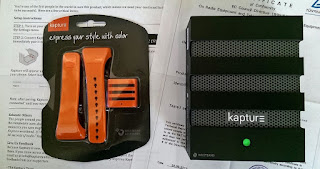This month's 'gadget guru' chat with Dave Hodgson on
TRE included some ideas for Christmas presents...
Gamevice mobile gaming controller
At the moment, certainly here in the UK, you can’t move without seeing an advertisement for some kind of Christmas game console deal. Either you’re spending a few hundred pounds on a Microsoft Xbox or you’re spending a few hundred pounds on a Sony PlayStation.
All the while you’re probably carrying around a powerful computer in your pocket: your smartphone.
Now, mobile gaming is very popular but for many people it’s not as good as a console because of the way you control the action. That’s where this company called
Gamevice comes on the scene.
They’ve made a games controller for iPhone 6, 6 Plus, 6s and 6s Plus devices. This kind of thing has been done before but what’s particularly nice with this product is the way it looks – it effectively clips on either end of your phone, leaving the screen in the middle. So you don’t have a separate controller; it all becomes one. It fastens magnetically and has its own rechargeable battery so it won’t drain the iPhone too quickly.
A typical console controller will have a four-way pad on one side, separate buttons on the other, perhaps a pair of joysticks and some kind of trigger or firing control for each hand. This does the same.
It works with over 750 iPhone games including some of the biggest: Minecraft, Final Fantasy 7, Halo, FIFA16, Tomb Raider, Grand Theft Auto… the company makes an app that lets you check which games work with its controller.
Pricing is £79.95 (€109.95) for the iPhone version – there’s also one available for the iPad Mini – and you can order online or find it in Apple stores.
Polaroid Zip instant photo printer
Once upon a time, in the olden days, we’d put film in our cameras, take photos and then get the film developed – which usually took about a week if you were relying on someone else to do it.
Then came the Polaroid camera, which produced instant pictures on special film.
And then came digital cameras and smartphones, which made it easier to print photos at home.
But there’s a bit of a trend away from printers at home – most of the time you don’t need one – which almost seems a backwards step, particularly when more photos are being taken than ever before.
So along came the
Polaroid Zip instant mobile printer earlier this year. It connects to your phone via Bluetooth (and if you’ve got NFC technology on your phone, you can connect simply by touching the two devices together).
The Zip printer itself is around 4 inches long: 120mm x 74mm x 23mm, weighing 186g and running off rechargeable batteries that’ll last for around 25 prints.
It costs £109.99 (around €150) and needs special photo paper, which works out at around 50p a go. This is Polaroid’s own paper called ZINK, which is short for zero ink. That means you don’t need to buy ink cartridges; like the old-fashioned film, the clever technology is in the paper. And what’s rather nice is you can peel off the back of the photos and they’ll stick to things. Photos are around 2 inches by 3 inches and, unlike a wet Polaroid, won’t smudge.
If you want something a little different, there’s a similar product on its way that actually clips to an iPhone or a Samsung Galaxy smartphone - this is the Prynt case - but that’s probably not going to be available until January next year.
Vinturi wine aerator
With red wine, most people tend to agree that it’s best to decant it or at least allow it time to ‘breathe’ before you start drinking – because it improves the aroma and the taste.
Which is all very well, but it doesn’t really work if you decide you fancy a glass of wine or if someone turns up for dinner with a bottle that you want to start straight away.
That’s where you need your
Vinturi aerator. It’s made of clear acrylic. You hold it over a glass, pour your wine through and it’s ready to drink.
The way it works – and you can hear it work – is that the wine pulls in air through little holes on the side of the device as it pours through. Unlike other devices, it doesn’t need batteries and it doesn’t need any waiting time, it simply uses basic physics.
I was given one of these for Christmas last year and I love it. I’m a bit embarrassed because they’ve been around for a few years but I’ve only just discovered them. Apparently it’s even dishwasher safe, although I just run it under the tap when I use it.
Pricing is usually somewhere around the £40 mark but here in the UK a few places have them on offer at the moment.
Perhaps best of all, it's a Christmas gadget that doesn’t need batteries!
Millennium Falcon Multi Tool
The new
Star Wars film comes out next week - and I’ve talked before about the Star Wars BB8 droid, which is going to be at the top of a lot of people’s Christmas shopping lists.
But I’ve found something else that’s much more practical and costs a fraction of the price. It’s a multi-tool in the shape of the Millennium Falcon (which, if you don’t know, is flown by Han Solo in the film).
Anyway, this is a modern version of the old bicycle spanner, which was a flat piece of metal with various hexagonal holes in it.
This Millennium Falcon Multi Tool is made on the same principle – and it can do 11 different things (12, if you include 'looking like a tiny spaceship').
There’s a screwdriver, a bottle opener, a wire stripper and a ruler as well as various spanners and a couple of other tools.
It’s officially licensed, it measures around 13cm long and 8cm wide – and it’s
£9.99. Keep it in your glovebox, in your handbag, in your briefcase, in your backpack – or in your cycle bag.
Once again, no batteries required.










